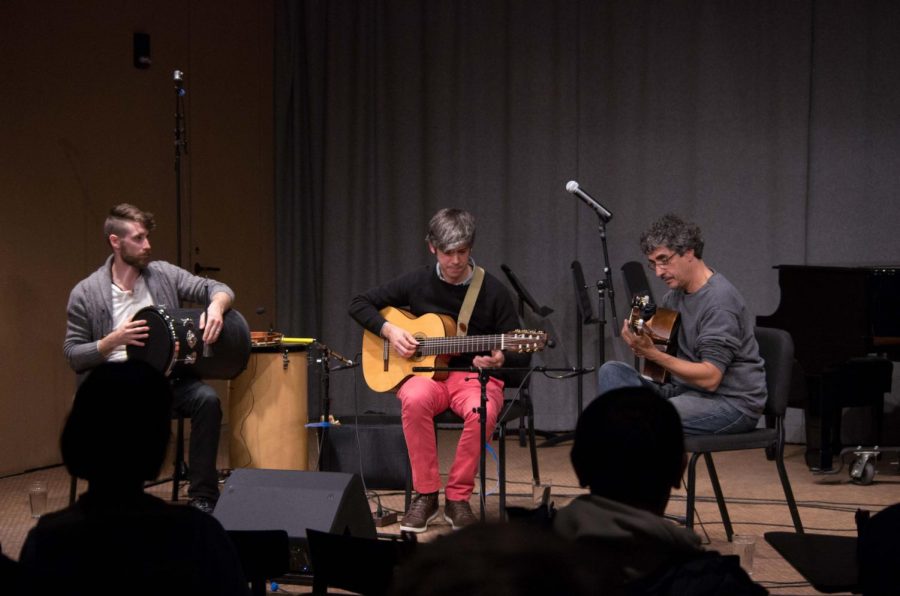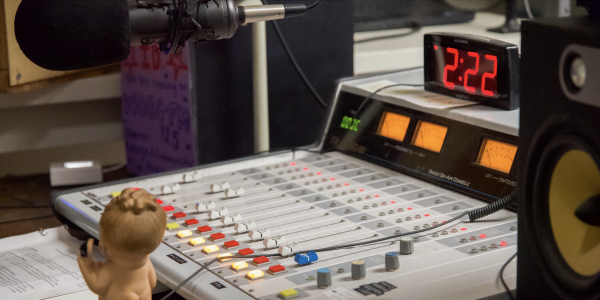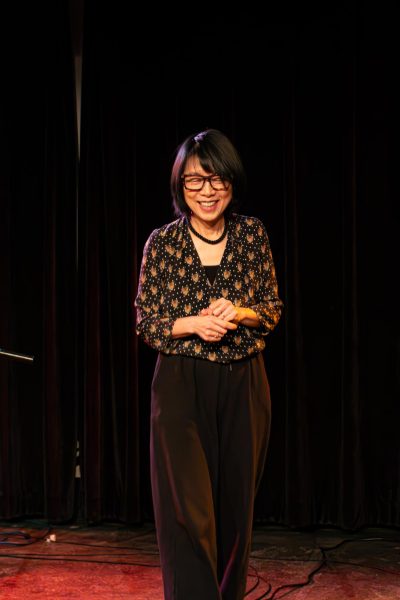Duo Violão Brasil Stages Varied Brazilian Guitar Performance
Photo by Hugh Newcomb, Photo Editor
Acclaimed Brazilian guitarists Rogério Souza and Edinho Gerber, with percussionist Lucas Ashby, perform a program of Brazilian music in the Birenbaum Innovation and Performance space Tuesday night.
Editor’s note: Quotes attributed to Rogério Souza in this article were translated by Edinho Gerber and Lucas Ashby.
Brazilian guitarists and members of Duo Violão Brasil, Rogério Souza and Edinho Gerber, stopped in Oberlin Tuesday night for a performance of Brazilian guitar, or violão, as part of Oberlin’s Performance and Improvising series. The guitarists, accompanied by D.C.-based percussionist Lucas Ashby, are currently touring the U.S. Their performances showcase the many styles of 20th-century Brazilian popular music, as well as the artists’ original compositions. After the performance, which took place in the Birenbaum Performance and Innovation Space, the musicians also led an interactive workshop for student musicians.
According to Souza, one of the main goals of the evening was to introduce students to the wide variety of styles present in Brazilian music.
“[We’re playing] pretty much traditional Brazilian music — so, you know, styles like choro, samba, bossa nova, baião,” Souza said. “All these different genres are kind of what we work on, both in terms of repertoire that already exists and stuff that I compose. Our goal tonight is to just provide an overview experience, musically, that provides some fundamental basic things about this music from Brazil that could be an entré to people taking this music, making it their own, and participating in the future.”
Gerber noticed that this performance might be particularly well-received in a community like Oberlin, where many people are curious about music history and evolution.
“Although you do get quite a good amount of Brazilian music that made its way over here to the U.S., especially as repertoire for jazz players, choro specifically is something that isn’t so well-known here,” Gerber said. “But it’s growing a lot. There are a lot more people interested in it, and it’s an interesting style of music, so we’re going to give a little taste of some different styles within that genre and different possibilities of what the music can be.”
By the time the event started at 8 p.m., the Birenbaum was filled with excited students, and the performers disappointed neither in their set list nor their execution. They moved fluidly between styles, highlighting the versatility of Brazilian music and the technical virtuosity of the guitarists. Though the performance began with only two guitars and one percussion instrument being featured at any one time, the musicians blended and played off of each other so perfectly that it often seemed that many more instruments were present. Students tapped their feet and bobbed their heads in time with the rhythms, clearly enjoying every piece.
At some points, the performers paused to give a brief history and context for the styles of the music that they were performing. They spoke about how their music parallels with musical history within the U.S., particularly in terms of the evolution of American jazz.
“Choro music started as parlor music in the 1850s,” Ashby said. “This music shares a lot of common ingredients with ragtime and jazz as it came up in New Orleans. It was an urban music, city music.”
“Rio de Janeiro, which is where this music comes from, in many ways was like New Orleans,” Gerber added. “They’re both port cities with influences from Europe, from Africa, from the Caribbean, and from Native peoples. And the musical fusion, there was a lot of similarity in taking traditional European jigs and dance music [like] polka and mixing it with African rhythms and stuff, and that’s where you got the rhythm known as maxixe, which is the first authentic Brazilian rhythm. Maxixe was the dance craze that came after the polka. It spread all over the world. It was very popular music. It was very taboo and risqué in Brazil when it first started, because it was very suggestive — people wanted to dance, it’s very syncopated, it wasn’t that traditional straight European rhythm. So it kind of caught fire the world over.”
Midway through the performance, Souza, Gerber, and Ashby invited Professor of Advanced Improvisation and Percussion Jamey Haddad and Associate Professor of Jazz Arranging Jay Ashby to join them onstage, to an enthusiastic audience. Haddad joined Lucas Ashby on percussion, while Jay Ashby brought out a trombone that he had left backstage and added brass to the mix. After the end of the performance, the musicians quickly transitioned into teaching a quick choro intensive and inviting students to get their instruments and join them. When talking about the workshop before the performance started, Gerber was certain that it would resonate with students.
“We’re going to share some of the rhythms and variations on the rhythms within each style of the music with the students,” he said. “Each category can be divided into sub-categories, and so there are some little variations that you have rhythmically, both in terms of accompaniment and melody — how the melodies are constructed. So we’ll be going through some songs in different styles with the students and have them participate. Hopefully it will rub off a little bit on them and they can take some of it home on them and further their interest in the music.”
According to Haddad, Gerber’s hopes were well-founded.
“From all appearances, the students would have played and danced all night if it had been an option,” Haddad wrote in an email to the Review.
The relationship between Oberlin and Duo Violão Brasil began over Winter Term 2018, when Haddad and Jay Ashby brought a group of 10 performance and improvisation students to Brazil. While there, the students studied in a workshop format with a number of Brazilian master musicians, attended performances, and performed at a Municipal Cultural Center Theater.
“When we were in Rio de Janeiro, all of the artists came completely prepared to give the students their generous attention and we met with them for six to seven hours each day,” Haddad wrote. “These Brazilian musicians are all performers with the highest reputations, having performed regularly with artists like Milton Nascimento, Hermeto Pascoal, Djavan, Chico Buarque, and Egberto Gismonti. In future years, we plan to alternate between India, Brazil, and Bali for winter term.”











